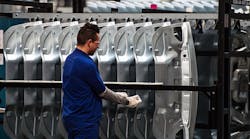NEW YORK — U.S. producer prices edged up in July in spite of the drag of lower energy prices on many goods, according to government data released Friday.
The Labor Department said its producer price index (PPI) rose 0.2% in July, slightly above the 0.1% increase projected by analysts. It marked the third straight month producer prices rose, a strong sign that inflation has stabilized.
Lower energy prices affected several product categories, such as residential natural gas, leading to a smaller PPI increase in July compared with the 0.4% gain in June and a 0.5% increase in May. Categories with gains included hotel and guestroom rentals, which jumped 9.9%.
Excluding food and energy prices, which are volatile, producer prices rose 0.3% in July, more than the 0.1% seen by analysts.
"Manufacturing’s rebound was widespread in July," MAPI Foundation chief economist Daniel J. Meckstroth said. “Production was up in 14 of the 20 major manufacturing industries. The rebound was led by exceptionally strong growth in motor vehicles and parts production and strong growth in wood products and plastic and rubber products. Motor vehicle production is a bright spot this year, with July’s production surge of 10.6% more than offsetting June’s 4.3% decline."
The Federal Reserve has spotlighted the need for stronger inflation as a leading condition to hike interest rates. Analysts said the July figures pointed to modest inflation.
"Manufacturing production was very weak in the first half of this year," Meckstroth said. "The severe winter, West Coast port work slowdown, collapse in oil prices, and strong dollar all combined to take a toll on growth. These headwinds will linger into the second half, so production is not expected to roar back. Nevertheless, a growth pickup was expected and the July numbers provide hard evidence that the pace of growth is improving. We foresee only 2.5% growth in 2015 manufacturing industrial production. With a return to normal winter weather, we predict 4.0% growth in 2016."
The Federal Reserve has spotlighted the need for stronger inflation as a leading condition to hike interest rates. Analysts said the July figures pointed to modest inflation.
"In short, slightly stronger than generally expected, but trends still look pretty tame," said Jim O'Sullivan, chief U.S. economist at High Frequency Economics.
"Much to chagrin of central bankers, the downward trend in wholesale inflation looks set to get worse as oil sinks to its lowest level in over six years," said Jay Morelock, economist at FTN Financial. "The Fed is eager to lift, however, and will likely chalk up the fall to another bout of temporary price weakness."
Copyright Agence France-Presse, 2015



